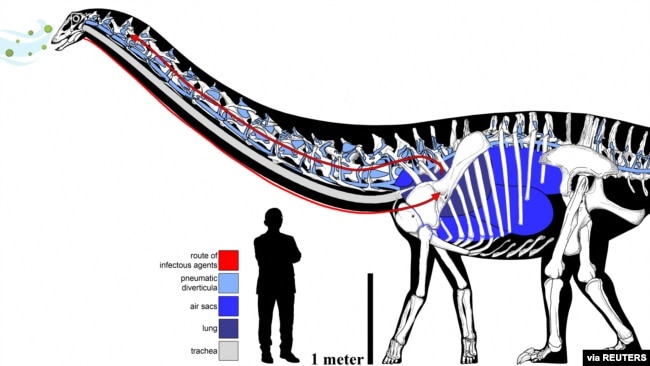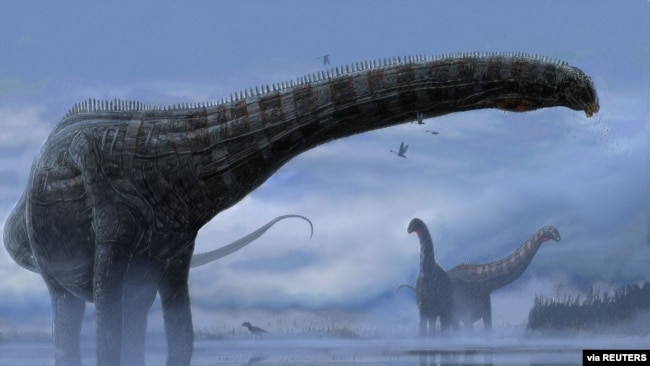恐竜も呼吸器を患っていた?!
研究者の言葉から、彼らの恐竜への愛が感じられました❣️ なぜかほっこり。
きっと恐竜たちも苦しかったでしょうね!!
太古から細菌による感染症と闘っていたのですね!!
VOAで英語を学びましょう!!
- 恐竜の呼吸器疾患の証拠を初めて発見(和訳)
- Scientists Find First Evidence of Respiratory Sickness in Dinosaur
- Scientists Find First Evidence of Respiratory Sickness in Dinosaur
恐竜の呼吸器疾患の証拠を初めて発見(和訳)
Scientists Find First Evidence of Respiratory Sickness in Dinosaur
February 17, 2022
アメリカの研究者が、恐竜が呼吸器系の病気に罹患していたことを示す最初の証拠を発見したと発表しました。
科学者によると、この恐竜はよく知られているDiplodocusディプロドクス科に近いようだといいます。この生物は、1億6300万年前から1億4500万年前のジュラ紀後期に生息していたと考えられています。
研究者たちは1990年にアメリカのモンタナ州で発掘されたディプロドクス類の骨の化石を調べました。その結果、首の骨3本に異常な成長が見られました。
このチームによると、 “Dolly””ドリー”と名付けられたこの恐竜は、アスペルギルス症に似た真菌感染症を患っていた可能性があるといいます。この病気は、現代の鳥類や爬虫類をしばしば死に至らしめる、一般的な呼吸器系の病気です。この病気はまた骨の感染症を引き起こすこともあります。研究者によれば、この病気がドリーを殺した可能性があるとのことです。
Aspergillosisアスペルギルス症は、真菌の粒子を吸い込むことによって起こります。現在、鳥類に見られる呼吸器感染症としては最も一般的なものです。鳥類は獣脚類と呼ばれる肉食で羽毛のある恐竜から進化したと考えられています。
恐竜も他の動物と同じように、病気に悩まされていました。しかし、化石の記録に病気の証拠が残っていることは稀です。なぜなら、軟組織は通常、化石化の過程で生き残ることができず、骨、歯、爪のような硬い体の部分が残るからです。
過去に恐竜の化石は、骨折や治癒、歯の感染症、骨の状態、癌などの証拠を示しています。しかし、これまで恐竜の呼吸器感染症の痕跡は見つかっていませんでした。
カリー・ウッドラフ 氏はこの研究を主導し、最近出版されたScientific Reportsにこの発見に関する研究論文を共同執筆しました。同氏は、モンタナ州マルタにある大平原恐竜博物館の古生物学部長を務めています。
ウッドラフ氏はロイターに対し、ドリーの体長は約18メートル、体重は約4~5トンだったと語っています。この恐竜は15歳から20歳の間に死んだと考えられています。
ウッドラフ氏は、今回の発見により、恐竜の病状に関する新たな情報が得られるとともに、この生物の呼吸システムの解剖学的構造に関する詳細も判明したと述べています。
Scientists Find First Evidence of Respiratory Sickness in Dinosaur
American researchers say they have found the first evidence of a dinosaur being affected by a respiratory sickness.
Scientists say the dinosaur appears to be closely related to the well-known Diplodocus family. The creatures are believed to have lived in the Late Jurassic Period from 163 to 145 million years ago.
Researchers examined the fossilized bones from a diplodocid unearthed in 1990 in the American state of Montana. They found abnormal growths on three neck bones of the dinosaur.
The team, which named the remains “Dolly,” says it appears the dinosaur may have suffered from a fungal infection similar to aspergillosis. It is a common respiratory sickness that often kills modern birds and reptiles. The sickness can also cause bone infections. The researchers said the condition may have killed Dolly.
Aspergillosis is caused by inhaling particles from a fungus. It is the most common respiratory infection found in birds today. Birds are believed to have evolved from meat-eating, feathered dinosaurs called theropods.
Dinosaurs suffered from sicknesses just like other animals. But evidence of sickness in the fossil record is rare. This is because soft tissue usually does not survive the fossilization process, which favors hard body parts like bone, teeth and claws.
In the past, dinosaur fossils have shown evidence of broken and healed bones, tooth infections, bone conditions and cancer. But, until now, no signs of respiratory infections in dinosaurs have been found.
Cary Woodruff led the research and co-wrote a study about the findings that recently appeared in the publication Scientific Reports. He is the director of paleontology at the Great Plains Dinosaur Museum in Malta, Montana.
Woodruff told Reuters that Dolly was about 18 meters long and weighed about 4 to 5 tons. The dinosaur is thought to have died at between 15 and 20 years of age.
Woodruff said the discovery provides new information about the medical conditions of dinosaurs, as well as details about the anatomical structure of the creature’s breathing system.
"I don't personally know of any fossil I've been able to sympathetically relate to more," Woodruff said.
Lawrence Witmer is an anatomist and co-writer of the study. He is with Ohio University Heritage College of Osteopathic Medicine. Witmer told Reuters the dinosaur likely felt a lot of the same symptoms as people do.
"Poor Dolly. She probably felt terrible with all the same signs and symptoms of a lower, respiratory infection that we experience,” he said.
Witmer added that there are still unanswered questions about the discovery. "Was Dolly so sick that she couldn't keep up with the herd? Did she die from this disease? Did she die alone?” he said.
Witmer added that the evidence suggests the dinosaur was sick for an extended period. He said the fossils showed Dolly was sick long enough for the condition to cause “reactive bone growth" in the body.
Words in This Story
respiratory – adj. relating to the process of breathing
fossil – n. part of an animal or plant that lived a long time ago that has been preserved in rock
fungus – n. any one of a group of living things (such as molds, mushrooms, or yeasts) that often look like plants but have no flowers and that live on dead or decaying things
evolve – v. to develop or make something develop over time
claw – n. one of the sharp, curved nails on the feet of some animals and birds
anatomy – n. the scientific study of the body and how its parts are structured
paleontology – n. a science dealing with the life of past geologic periods as known from fossil remains
sympathetic – adj. showing that you understand and care about other people and things
osteopathy – n. the study and treatment of injuries to bones and muscles
symptom – n. a change in the body or mind which indicates that a disease is present


